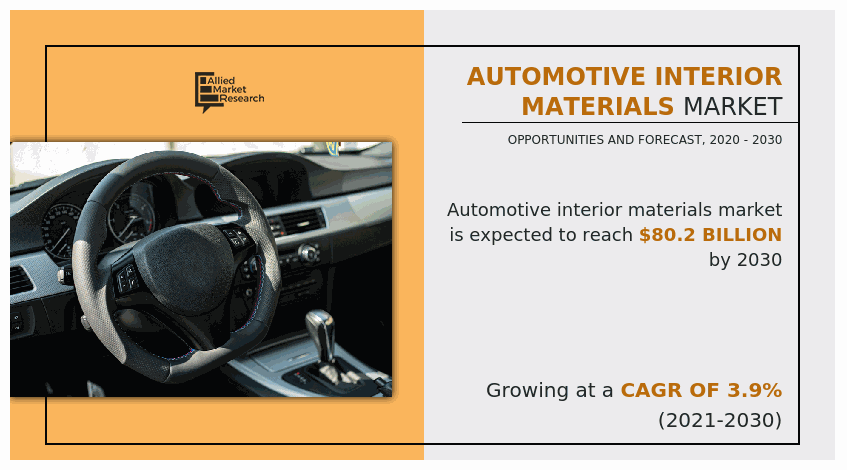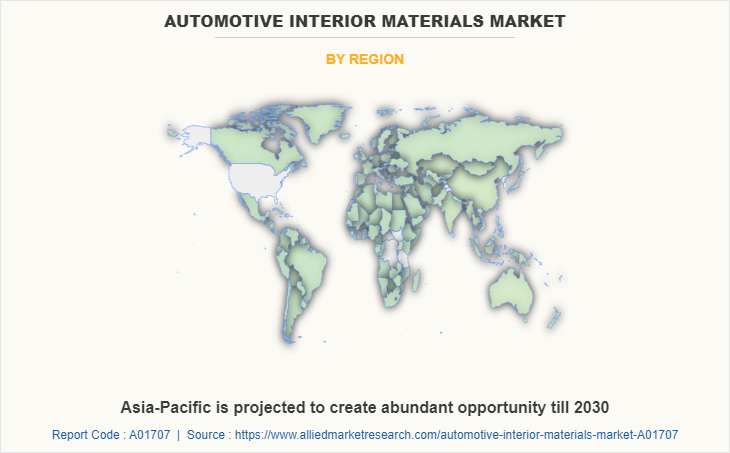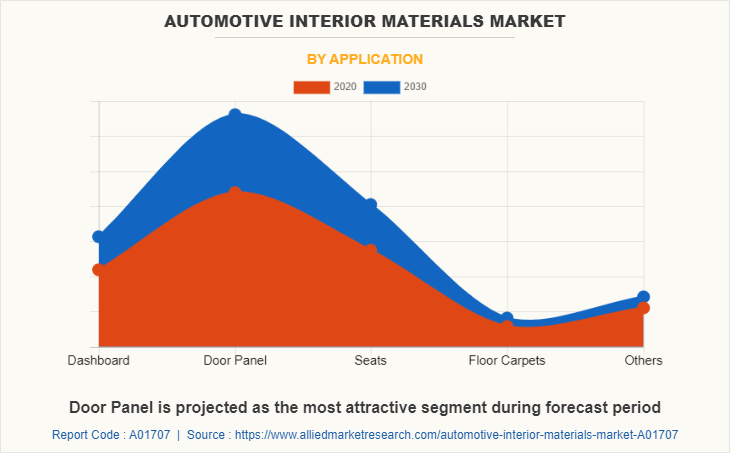Automotive Interior Materials Market Size & Insights:
The global automotive interior materials market size was valued at $55.0 billion in 2020, and is projected to reach $80.2 billion by 2030, growing at a CAGR of 3.9% from 2021 to 2030. Technological innovations in automotive interior materials are significantly driving the demand for the automotive interior materials market. Advances in lightweight, durable, and sustainable materials are transforming vehicle interiors, offering better comfort, performance, and environmental benefits. Innovations such as the use of eco-friendly composites, enhanced textiles, and smart materials that integrate sensors and other digital features are gaining traction. As a result, there is expected to be high demand for the automotive interior materials market during the forecast period.
Introduction:
Automotive interior refers to the internal components and design elements within a vehicle that contribute to its functionality, comfort, safety, and aesthetic appeal. Automotive interior components include seats, dashboards, door panels, flooring, headliners, trim, upholstery, and various electronic and technological features such as infotainment systems, climate control, and lighting. Automotive interiors are designed to enhance the user experience by providing comfort, convenience, and a pleasant environment, while also meeting safety standards and regulations. Materials used in automotive interiors range from textiles, leather, and plastics to advanced composites, with increasing emphasis on sustainability and innovation.

Market Dynamics
Technological innovations in automotive interior materials are driving significant demand for the automotive interior materials market by introducing advanced, lightweight, durable, and sustainable options that enhance vehicle performance and consumer experience. The development of eco-friendly materials, such as bio-based plastics and natural fiber composites, is aligning with the growing demand for sustainability in automotive design. In addition, innovations in smart materials, such as temperature-regulating fabrics, sensors integrated into upholstery, and ambient lighting systems, are improving both the functionality and luxury of vehicle interiors. The rise of electric vehicles (EVs) and autonomous vehicles is further accelerating this trend, as manufacturers seek materials that reduce weight, increase energy efficiency, and improve safety. All these factors are expected to drive the demand for the automotive interior materials market.
However, the high cost of advanced automotive interior materials hampers the growth of the automotive interior materials market by limiting their widespread adoption, particularly among cost-sensitive consumers and manufacturers. Premium materials such as high-performance composites, sustainable fabrics, and smart materials often come with significantly higher production and sourcing costs, making them less accessible for mass-market vehicles. This price barrier can prevent automakers from incorporating these innovations into lower-priced models, slowing the overall market expansion. All these factors hamper the growth of the automotive interior materials market.
Advancements in lightweight materials are creating significant opportunities for the automotive interior materials market by enabling more efficient and innovative interior designs. The adoption of lighter materials, such as advanced composites, carbon fiber, and lightweight plastics, helps reduce vehicle weight, improving fuel efficiency and overall performance. This is particularly crucial for the growing electric vehicle (EV) market, where weight reduction is essential to extend battery range. In addition, lightweight materials allow for more flexible and creative interior designs, enabling automakers to enhance comfort, space, and aesthetic appeal without compromising on durability or safety. All these factors are anticipated to drive the demand for the automotive interior materials market.
Segments Overview:
The automotive interior materials market is segmented into By Type, By Vehicle Type and Application.
Automotive interior materials are the materials utilized in the interior of the automotive. Fabric, polymers, genuine leather, and synthetic leather are primary materials utilized in the automotive interiors. Increase in focus on overall weight reduction of automobiles to optimize fuel efficiency is the crucial factor that drives automotive interior materials market growth. Furthermore, increase in consumption of plastics in automotive production across the globe boosts the demand for automotive interior materials. Key automotive producers focus on lessening carbon emissions by employing lightweight plastics and composites in vehicle dashboards, instrument panels, and flooring components. Moreover, surge in adoption of green technology to produce automotive leather is expected to provide lucrative growth opportunities for the automotive interior materials market. However, high volatility in the prices of raw materials hinders the growth of the global automotive interior materials market.
On the basis of material, the market is segmented into plastics, composites, fabrics, leather, and others. Depending on vehicle type, it is classified into passenger cars, light commercial vehicle, heavy commercial vehicle, and others. According to application, it is categorized into dashboards, door panel, seats, steering wheels, floor carpet, and others. The door panel segment accounted for the highest market share in 2020, owing to surge in usage of automotive interior materials in door panels of the vehicles to enhance aesthetic appeal. Region wise, the automotive interior materials market is analyzed across North America, Europe, Asia-Pacific, and LAMEA. Asia-Pacific holds the largest share of the automotive interior materials market forecast period. Increase in adoption of automotive interior materials products, owing to rise in urbanization, surge in economic development, and growth in automotive sector in China, India, Japan, South Korea, and Thailand boost the demand for automotive interior materials in the region.

Automotive Interior Materials Market By Region
Asia-Pacific dominates the automotive interior materials market and consists countries, including China, India, Japan, and rest of Asia-Pacific. Growth in the automotive industry and increase in adoption of electric vehicles in the region stimulates the demand for automotive interior materials. Furthermore, rise in population and surge in disposable income of the population in the developing countries fuel the market growth. Moreover, development in plastic and composite components propels the growth of automotive interior materials market.
By Type
Composites is projected to create abundant opportunity till 2030
Automotive Interior Materials Market By Type
Depending on type, the plastics segment dominates the global automotive interior materials market. The growth is attributed to its excellent mechanical properties along with excellent aesthetical appearance. Furthermore, these plastics allow for complex designs in airbag housings, center stacks for instrument panels, and large, integrated instrument panel pieces. These help lessen vibration, noise, and harshness in the automobile interior.
By Vehicle Type
PV segment is projected as the most lucrative segment.
Automotive Interior Materials Market By Vehicle Type
The passenger cars segment dominates the global automotive interior materials market, owing to rise in standards of living of the population in developing countries and increase in shift of the production facilities of various manufacturers. Passenger cars comprise the vehicles utilized for transportation of passengers. Technologies employed in the passenger vehicles change frequently, owing to surge in consumer demand for luxurious as well as convenience features. Manufacturers of passenger vehicles focus on production of vehicles that offer safety, luxury, and exquisite ride quality to the passengers.

Automotive Interior Materials Market By Application
According to application, door panel segment holds the highest share, owing to the ease of processing and application of automotive interior materials. The door panels serve as an interface between the car interior and inner workings of the door, and between vehicle occupants and the door. These meet various design specifications regarding aesthetics, safety, and functionality.
Competitive Analysis
The key players profiled in the report include 3M, ARKEMA Group, BASF SE, Covestro AG, Dow, Evonik Industries AG, HEXCEL CORPORATION, HUNTSMAN INTERNATIONAL LLC, STAHL HOLDINGS B.V., and WACKER CHEMIE AG.
Other companies operating in the automotive interior materials industry include Bayerische Motoren Werke AG, Celanese Corporation, Delphi Automotive Plc Grammer AG, Grupo Antolin-Irausa SA, Technical Textile Services Ltd., Toyota Boshoku Corporation, Toyoda Gosei Co., Ltd., and ZF Friedrichshafen AG.
These companies compete for automotive interior materials market share through product launch, joint venture, partnership, and expansion of the production capabilities to meet the future demand for the automotive interior materials during the forecast period. For instance, in February 2022, BASF announced the business expansion of products , including polyamides (PA) and polyphthalamides (PPA) in Europe that it acquired as part of the takeover of Solvay’s PA66 business. These engineering plastics, previously sold as Technyl, will continue at BASF under its established brand name Ultramid. Customers benefit from a vast plastics portfolio, including both PA66 grades and Ultramid One J, a PPA based on PA66/6T.
Key Benefits For Stakeholders
- This report provides a quantitative analysis of the market segments, current trends, estimations, and dynamics of the automotive interior materials market analysis from 2020 to 2030 to identify the prevailing automotive interior materials market opportunities.
- The market research is offered along with information related to key drivers, restraints, and opportunities.
- Porter's five forces analysis highlights the potency of buyers and suppliers to enable stakeholders make profit-oriented business decisions and strengthen their supplier-buyer network.
- In-depth analysis of the automotive interior materials market segmentation assists to determine the prevailing market opportunities.
- Major countries in each region are mapped according to their revenue contribution to the global market.
- Market player positioning facilitates benchmarking and provides a clear understanding of the present position of the market players.
- The report includes the analysis of the regional as well as global automotive interior materials market trends, key players, market segments, application areas, and market growth strategies.
Automotive Interior Materials Market Report Highlights
| Aspects | Details |
| By Type |
|
| By Vehicle Type |
|
| By Application |
|
| By Region |
|
| Key Market Players | SAGE AUTOMOTIVE INTERIORS, INC., BASF SE, DK-SCHWEIZER CO., EAGLE OTTAWA LLC, JOHNSON CONTROLS, INC., BORGERS SE & CO. KGAA, FAURECIA AUTOMOTIVE GMBH, THE DOW CHEMICAL COMPANY, BENECKE-KALIKO AG, KATZKIN LEATHER, INC., E.I. DU PONT DE NEMOURS & CO., LEAR CORPORATION |
Analyst Review
Automotive interior materials are used in the production of headrests, seat covers, door panels, consoles, floor mats, and dashboards of the automobiles. Automotive interior materials are used in passenger cars, light commercial vehicle, and heavy commercial vehicles. The use of automotive interior materials witnessed quite a notable growth in the past years as these materials were used for overall weight reduction of vehicles to optimize fuel efficiency, offer optimum comfort, extended vehicle durability, excellent stiffness, strength, longevity, enhanced acoustics, and improve overall vehicle performance.
Key factors such as increase in demand for luxury and lightweight vehicles in developed and developing countries, rise in vehicle customization activities, surge in consumption of plastics in automotive production, and growth in electric vehicles market boost the growth of the market during automotive interior materials market forecast period. Furthermore, surge in adoption of green technology in manufacturing automotive leather is expected to provide lucrative growth opportunity for the automotive interior materials market growth.
Asia-Pacific dominated the market in 2020, owing to increase in population, development in the automotive sector, and rise in stable economic growth. Developing countries, such as India, Japan, and China register increase in demand for these automotive interior materials during the forecast period. Furthermore, significant growth in demand for composite and plastic parts drives the market growth.
Estimated Market size of Automotive Interior Materials Market is $55 billion in 2020
Increase in focus on overall weight reduction of automobiles and increase in consumption of plastics in automotive production are the major driving factor for the market. In addition, surge in adoption of green technology to produce automotive leather may create lucrative opportunities for the market.
Technological evolution in automotive industry, increasing demand of cars and rising modification culture in cars are the current trend expected to influence the global Automotive interior material market in the next few years.
Rapid increase in industrialization and increase in urbanization and continuous increase in demand of cars which in turn to increase the demand of automotive interior material which is expected to drive the adoption of Automotive interior material.
Automotive industry and small car resellers are the major customers of global Automotive interior material market.
Door panel segment holds the maximum share of the global Automotive interior material market
Loading Table Of Content...



